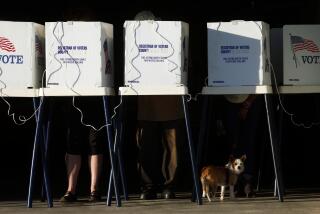At This Point, the Polls Toll for Bush
- Share via
It’s too early to rely on polls to predict exactly what will happen in the 2004 presidential election, but the data we do have, set in the context of recent history, provide some patterns worth watching.
First, consider job approval. President Bush has a 50% job approval rating at the moment. Gallup Poll archives since 1952, when modern polling techniques came into play, show that his rating is slightly below those of the most recent successful candidates for reelection. In March of their election years, Bill Clinton had a job approval rating of 52%, Ronald Reagan had a rating of 54% and Richard Nixon had a rating of 53%. The two other successful incumbents since 1952, Dwight Eisenhower and Lyndon Johnson, had even higher job approval ratings at this point in 1956 and 1964. (And the losers? Gerald Ford had a job rating of 50% in March 1976, identical to Bush’s, while George H.W. Bush’s and Jimmy Carter’s ratings were 41% and 43% at this time in 1992 and 1980.)
History shows that the incumbent’s approval rating can change substantially as the year progresses. The factor to watch is the trend: It won’t be auspicious for the president should his ratings drift downward.
There are also less-than-positive signs for Bush when we look at a more direct measure: the hypothetical “trial heat” ballot pitting an incumbent against his opponent. In February and so far in March, each trial heat conducted by Gallup shows Kerry beating Bush.
Some arguments have been advanced that it is “normal” for an incumbent president to be losing to his opponent at this stage, given intense media coverage of the challengers in the primaries and the fact that the “real” campaign hasn’t begun.
But the numbers show otherwise. Since 1956, of eight presidents who sought a new term, five won. Two of these eventual winners started their reelection years on somewhat shaky ground but quickly recovered. Reagan was tied with Walter Mondale in a Gallup poll survey taken in January 1984. Clinton was behind Bob Dole in two Gallup polls conducted in January 1996. But from February 1984 on, Reagan was ahead of Mondale in every trial-heat ballot that Gallup conducted. And, in similar fashion, Clinton was ahead of Dole in every trial-heat ballot Gallup did from February on in 1996.
The other three incumbent presidents who won a new term in the second half of the 20th century -- Eisenhower, Johnson and Nixon -- never once fell behind their opponents in the election year. Nixon, for example, was ahead of McGovern in every trial-heat ballot Gallup conducted in 1972, ranging from margins of 13 points to 24 points, despite less than overwhelming job approval ratings.
In fact, it’s usually the case that incumbents -- whether they end up winning or losing in their reelection bids -- start the election year doing well in trial heats. Two out of three of the incumbent presidents who went on to lose their elections were actually ahead of their eventual opponent at this point in their reelection bids. Carter was ahead of Reagan until June 1980 (they traded the lead off and on later). George H.W. Bush was ahead in every poll conducted in early 1992 until Ross Perot jumped ahead in May. (Clinton didn’t move into the lead until Perot dropped out in July.) Gerald Ford was behind his eventual opponent, Carter, in early polling, although Gallup did not begin pitting Ford against the little-known former Georgia governor until March 1976.
Obviously, this is not particularly good news for Bush. But there are caveats. The sample -- eight cases -- is small, and it doesn’t include the famous election of 1948, in which an incumbent president, Harry S. Truman, was behind in the polls of the time but went on to win.
Still, if Bush is reelected, he will become the only president out of the last eight incumbents to win after having been behind a challenger in Gallup polling conducted after January of his election year. And, if his job approval ratings don’t rise above 50% in April and May, his reelection would mark the first of those eight to win with less than majority approval in the late spring of their election year.
More to Read
Sign up for Essential California
The most important California stories and recommendations in your inbox every morning.
You may occasionally receive promotional content from the Los Angeles Times.










